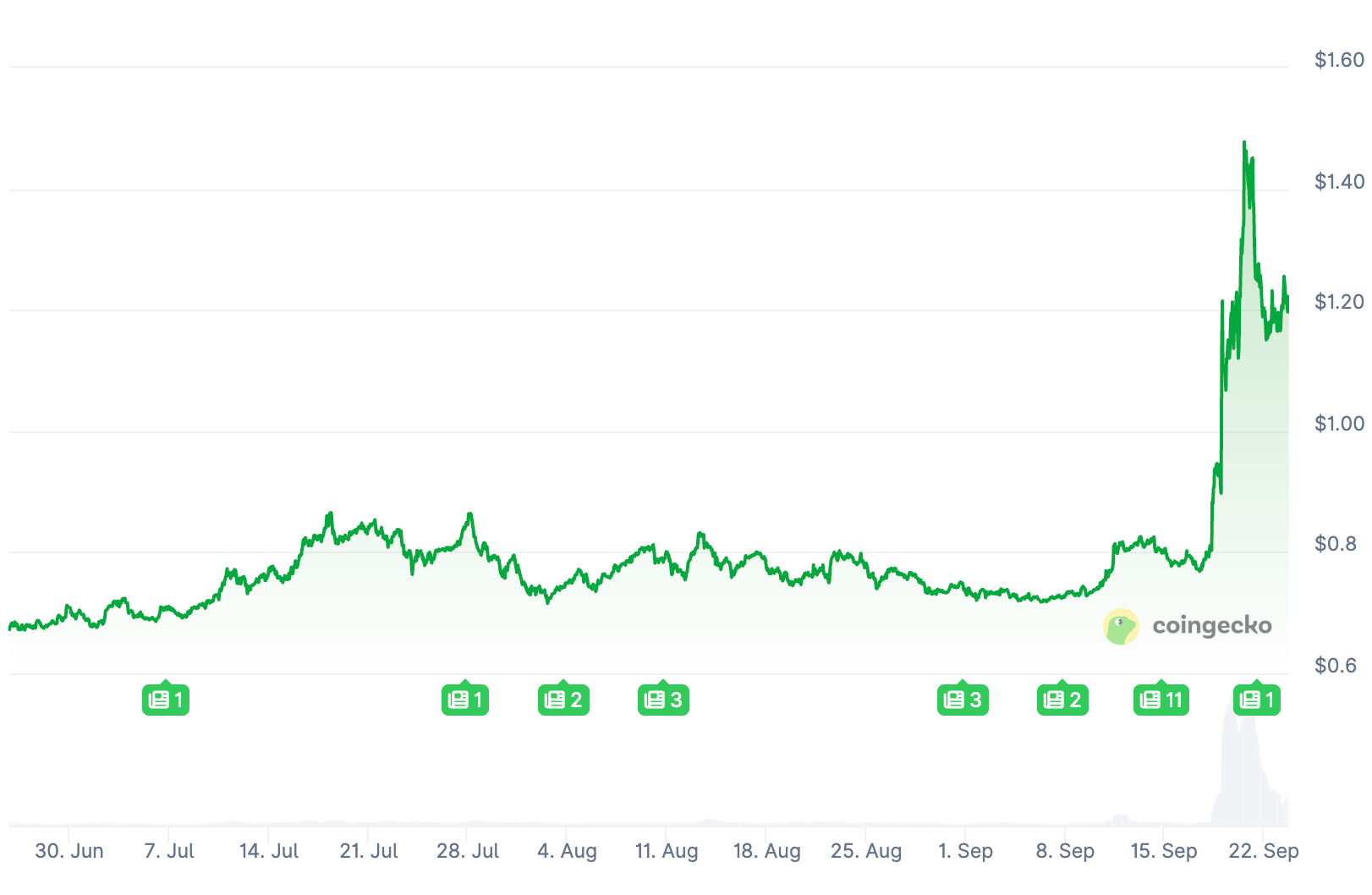- The Vester Pulse
- Posts
- Blood in the Charts, Buzz on the Doge
Blood in the Charts, Buzz on the Doge
ETF filings bring attention to Memecoins during a broader downturn
Vester Updates
We’ve rolled out a major product update across all three core agents.

The On-Chain, News & Sentiment, and Quant agents have been significantly enhanced. While these have been live for some time, they now deliver more structured outputs, cleaner visualizations, and faster, more consistent performance.
Latency has improved meaningfully, especially on more complex, multi-agent queries. Chart rendering is more reliable, formatting has been tightened, and outputs feel more coherent across use cases.
We’ve also shipped several UI and UX improvements, that should be noticeable immediately. This release reflects the culmination of a month plus of iteration. The core product is now faster, clearer, and better equipped to serve as a unified research environment for crypto analysis.
Let us know what you think - https://vesterai.com/.
Market Updates
Market Overview — September 23, 2025
| Segment | Current Value | Change (7d) |
|---|---|---|
| Global Market Cap | ||
| Total Crypto Market | ≈ $3.96 T | ↓ ~1.5 % |
| Sector Performance (GMCI) | ||
| DeFi (GMCI DeFi Index) | 87.8 | ↓ 11.9 % |
| Layer‑1 (GMCI L1 Index) | 210.0 | ↓ 3.3 % |
| Top Coins (Tracker) | ||
| Bitcoin (BTC) | ≈ $112,122 | ↓ ~4.0 % |
| Ethereum (ETH) | ≈ $4,184 | ↓ ~6.5 % |
| Solana (SOL) | ≈ $215.88 | ↓ ~5.5 % |
| BNB (Binance Coin) | ≈ $1,018.50 | ↑ ~2.5 % |
| XRP (Ripple) | ≈ $2.85 | ↓ ~6.0 % |
Crypto News
Crypto markets drifted lower this week, with total capitalization pulling back to approximately ~$3.96 trillion. The move reflects a broad cooling across most major assets after a period of elevated volatility and positioning.
Bitcoin declined roughly 4% to around $112,100, while Ethereum dropped more sharply, falling over 6% to ~$4,180. Solana also retreated, shedding around 5.5%, while BNB managed to post a modest gain of 2.5%. XRP saw a decline of approximately 6%, reversing some of its prior strength.
Sector performance was more sharply bifurcated. The GMCI Layer-1 Index slipped 3.3% to $210.0, reflecting weaker performance across smart contract platforms despite relative resilience from larger names. Meanwhile, the GMCI DeFi Index fell 11.9% to $87.8, one of its largest weekly drops in recent months, as protocols across lending, DEXs, and synthetic assets gave up ground.
The broader narrative remains relatively cautious. Despite continued institutional engagement and long-term builder momentum, markets appear to be consolidating.
BitGo Files for IPO
BitGo has filed to go public on the New York Stock Exchange under the ticker BTGO. According to its S-1, the company brought in $37.5 million in revenue during the first half of 2025, up fourfold from the same period last year.
Net income fell to $6.3 million from $16 million, reflecting increased hiring, legal, and compliance costs as BitGo scaled its institutional services.
Founded in 2013, BitGo is one of the longest-operating custody providers in the space. It manages over $3 billion in assets, operates the Wrapped Bitcoin (WBTC) issuance platform, and recently expanded into staking and settlement infrastructure. It has long served as a backend for large exchanges, funds, and fintechs that need regulated digital asset custody without building it in-house.

The company was nearly acquired by Galaxy Digital in 2021 for $1.2 billion, but the deal collapsed over regulatory delays. Since then, BitGo has operated independently and built deeper ties with qualified custodians, auditors, and enterprise clients. It has positioned itself as a neutral infrastructure provider in a market where many custodians are vertically integrated with trading or brokerage arms.
If the listing proceeds, BitGo will become the first standalone crypto custodian to trade publicly in the United States.
That would not only set new benchmarks for valuation, but also serve as a proxy for how investors price infrastructure businesses that sit one layer beneath the exchanges, token issuers, and ETF sponsors that dominate headlines.
ETF Access Expands
On September 18, the SEC approved generic listing standards for spot crypto ETFs, allowing exchanges like Nasdaq, NYSE, and Cboe to list digital asset products without requiring case-by-case rule changes.
Previously, each ETF - even those backed by Bitcoin or Ethereum - faced a months-long approval process under Section 19(b). The new framework streamlines filings under pre-cleared conditions, significantly reducing both the timeline and legal burden for issuers.
Just days after the ruling, REX Shares launched the first Dogecoin ETF (ticker: DOJE), marking a pivotal shift in regulatory posture toward memecoins and non-blue-chip assets.
The fund mirrors traditional spot ETF structure with regulated custody and NAV tracking, but tracks a token long dismissed as speculative. Its approval signals that a broader range of digital assets may soon find a home in regulated investment wrappers.

The implications are significant. Asset managers now have a fast, formalized path to market. Retail investors gain exposure to riskier tokens via brokerage accounts, while institutional flows may begin to rotate from centralized exchanges into ETF rails.
If volumes materialize (they will), this change could reshape market structure - shifting liquidity, compressing volatility, and further entrenching crypto in traditional capital markets.
Bahrain formalizes digital asset rules
Bahrain has introduced a new law establishing legal parameters for stablecoins and broader digital asset activity. The framework, developed by the Central Bank of Bahrain, aims to provide legal clarity for issuance, custody, and payments infrastructure tied to fiat-pegged digital assets. It includes provisions for licensing, reserves, redemption, and real-time auditability.

The law positions Bahrain as one of the first jurisdictions in the Middle East to formalize stablecoin operations under a national regulatory regime.
While the UAE has attracted attention through its virtual asset service provider framework, Bahrain’s approach is narrower and more targeted. The focus is on settlement, compliance, and providing regulatory certainty to institutions looking to build payment rails or custody services.
The move reflects a broader trend among smaller, finance-forward nations establishing regulatory clarity ahead of larger Western jurisdictions. As global stablecoin volumes continue to rise, legal clarity around issuance and redemption will be a key driver for where fintechs, payment networks, and on-chain settlement platforms choose to operate.
For teams building real-world applications of stablecoins, Bahrain now presents a sandbox with clear rules. That includes treasury protocols, yield-bearing stablecoin wrappers, and even banks exploring tokenized deposits.
The new law does not directly touch algorithmic or non-collateralized models, reinforcing that the regulatory appetite remains centered on fiat-backed instruments.
Token of the Week
Trust Wallet Token is the utility and governance token of Trust Wallet, a mobile-first, self-custody crypto wallet that supports multiple blockchains, including Ethereum, BNB Chain, and Bitcoin. The wallet offers in-app swaps, staking, NFT support, and dApp connectivity, serving as a popular alternative to browser-based wallets.
TWT is used for fee discounts, in-app incentives, governance participation, and ecosystem rewards. Its value accrues from active wallet usage and integrations with protocols that rely on Trust Wallet’s infrastructure.
The token does not have ongoing emissions, and a significant portion of its supply is already in circulation, which has helped limit dilution pressure. This has made TWT one of the more resilient utility tokens tied to crypto infrastructure adoption.
This week, TWT saw a sharp increase in trading volume and price, rising over 30% (see below) as wallet usage spiked and narratives around self-custody regained attention.

The move appears to be driven by a mix of organic user activity, high-profile endorsements, and short-term rotation into mid-cap tokens with defensible use cases. While price action may cool as profit-taking sets in, TWT is one of the few tokens showing clear relative strength in a mostly flat market.
The key risk is sustainability. Without continued growth in wallet integrations or new features, speculative interest may fade. But as regulatory uncertainty continues to drive attention back toward non-custodial tools, TWT is well-positioned to benefit.
Closing Thoughts
With the product updates noted above, our core agent stack is live.
On-Chain, News & Sentiment, and Quant agents are now operating in production with improved performance, faster outputs, and more consistent formatting.
This marks a meaningful step toward the experience we’ve been building - one where research, analysis, and execution can happen in a single interface.
Next up: portfolio integration, improved context/memory, and so much more.
Until then, the current stack is live and ready to use - please provide us with feedback as we continue to ship bug fixes and updates